Dreaming of Europe, Mark Temby discovered southern Tasmania is rich cycle touring territory in itself.
Where do you ride when you’ve pedalled all the paths, ridden all the rail trails and exhausted the charms of your commute?
My mind turned to cycling in France, Italy or along the Danube, and with my wife Cathy, I planned a European odyssey. After much preparation, during May, June and July of 2014, we rode over 2,600 kilometres from Paris to Marseille along the Loire Valley, to Bordeaux, along the Canal du Midi, along the Mediterranean coast to Pont du Gard, Avignon and via the Luberon.
But I’m here now to tell you about a much more modest sojourn, much closer to home, but a ride with many compelling charms of its own. Our Huon–D’Entrecasteaux tour was conceived as a test for the touring in France. It gave us an opportunity to pack our touring bikes with the clothes and camping gear we would later use in France and ride 240 kilometres over a few days to test our desire and ability a little closer to home. Part of our challenge was to pack a minimal amount of gear as we intended to use only two rear pannier bags each with space needed for two bike bags.
As well as confirming our plans, the route revealed myriad delights in its own right. This is a region every bit as spectacular as the other side of the world, combining food, wine, cider and wilderness in a compact experience conveniently starting and finishing in Hobart.
This self-guided tour is around 240 kilometres in length, but the circuit is best paced out with plenty of relaxing rest days of tasting ciders with cheese, award-winning pinot noir by a river, camping on Bruny Island, eating oysters on the beach or embarking on an award-winning wilderness cruise. The ride is highly suitable for both touring bikes and credit card cycling with many Bed & Breakfast accommodation options en route. The best time is from September to April with your choice of spring, summer or autumn seasons in all their glory.
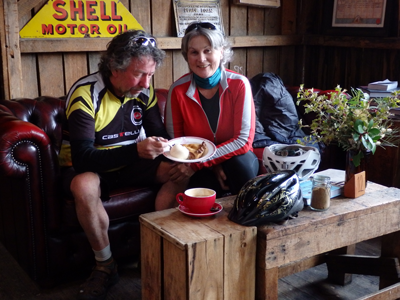
While there is a wealth of riding from Hobart on various day-ride loops such as to MONA, the Mt Wellington summit and the Pipeline Track, and sights to see, we’re focused here on the treasures to the south. You can also ride from Hobart airport, which is 19km east of the city. Alternatively, you can put a bike bag/box on the airport bus. The route I recommend from Hobart climbs Mt Wellington to Fern Tree on Cascade Road, travels along a contour and drops to Longley before climbing again to Lower Longley before dropping into the Huon Valley.
When we set out early one morning in September, it was from Lucaston in the valley, where we were based. The Huon Valley nestles under the reclining profile of Sleeping Beauty, the poetic name of the bordering mountain range. So it’s appropriate that the valley has been known for its apples and now its boutique cider houses: Willie Smiths near Huonville, Franks out of Franklin and Pagan Cider in Cygnet. Willie Smiths is on this route and hosts local entertainment on Friday nights and monthly on Sundays. The local ciders all use apples, pears and cherries but are quite different. While on the subject of drinks it would be remiss of me not to mention the wineries. Home Hill winery at Ranelagh won the best Tasmanian Pinot Noir in 2014.
We glided downhill towards Ranelagh and Huonville. It was cold enough to be wearing merino skivvies, gloves and leg warmers. The plan was to take it easy and enjoy the trip so we stopped after just 6 kilometres at the Summer Kitchen bakery and café in Ranelagh for a coffee.
The Huon River has its headwaters around Lake Pedder and flows dark with tannins, making any amount of reflective photo opportunities on a still day. On this day a mist blanketed the water. We took the chance for a photo as the view extends back up the river towards the omnipresent Sleeping Beauty. At our feet the dorsal fin of a feeding salmon snaked through the shallows and cut the mist. The Huon is well known for its salmon farms with local fishermen often savvy to the latest escapes.
The Channel Highway runs parallel to the Huon and the river quickly widens around Egg Islands as it flows into D’Entrecasteaux Channel and on into the Tasman Sea. Around 8 kilometres from Huonville we turned right past Cradoc onto the Cygnet Coast Road. The Cygnet Coast Road is a popular scenic day loop for local cyclists.
Cycling along the Cygnet Coast Road only covers 22 kilometres but it is quiet with glorious views towards the Hartz Range and Adamson’s Peak while the river is almost one with the road. Black swans are numerous but keep an eye peeled for sea eagles and wedge tailed eagles. For a short distance the road becomes dirt before turning inland past some blueberry farms. The farms do sell to the public but harvesting is around January. Back on the asphalt the road roller- coasters and winds into Cygnet with views over Port Cygnet. Road bikes might wish to avoid dirt roads such as the Cygnet Coast Road (about 9 kilometres are dirt) by staying on the Channel Highway into Cygnet.
Cygnet was our designated lunch stop with two notable eateries in the Red Velvet Lounge and Lotus Eaters’ Café. Many cyclists do loop rides around Cygnet on weekends as there are easy- to-moderate rides and more difficult rides like Woodbridge Hill. In January each year Cygnet hosts the Cygnet Folk Festival. It may not draw the big names like Port Fairy or Woodford but it makes up for it with local ambience and quality performances. If you time your ride for January, camping should be booked with the weekend festival pass.
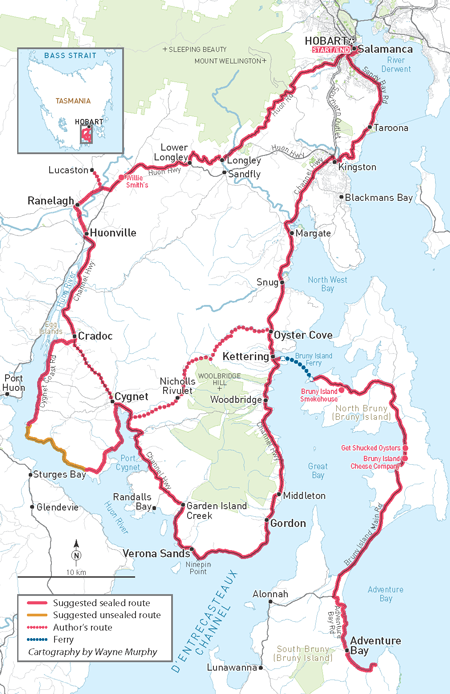
Leaving Cygnet the ride continued along the Channel Highway towards our planned overnight stop at a public camping ground in Gordon. A short climb led to a lookout over Randall’s Bay with superb views over the far southern coast of Tasmania and South East Cape. We decided against a ride down to the beach because we didn’t want to swim in September. The real reason was that we would have lost all altitude only to have a climb back to the lookout.
The highway continues around the coast past the holiday village of Verona Sands and Ninepin Point. Ninepin Point is a marine reserve as the tannin rich waters of the Huon River meet the sea of the D’Entrecasteaux Channel. This creates a layer over the salt water reducing the penetration of light and making soft corals and other marine life believe they exist in 40 metres of water when it is only less than 5 metres. From this point the highway swings north back towards Hobart along the channel with views towards Bruny Island. Again the views turn to superb.
By the time we arrived in Gordon it was dusk and a wind from the south west was beginning to blow. By the time our tent was pitched there was one lone sailing boat in the channel leaning 30 degrees from the vertical. It was time to test our micro-light tent. Despite being buffeted by the wind all night we survived for an early morning departure.
A later departure would have opened options of Peppermint Bay for lunch and Grandvewe Sheep Cheese, but our plan was to catch the 9:30 Bruny Island ferry after breakfast at Kettering’s Mermaid Café. Sitting in a glass windowed café at the marina with an egg and bacon roll and coffee was just reward for the effort. The ferry crossing is short and free for pedestrians and bicycles.
Once you enter Bruny there are only two traffic crushes. The first is when cars disembark the ferry at Roberts Point. The second is when cars try to arrive at Roberts Point before the ferry departs. If you avoid these times, which is relatively easy by being the last to disembark for example, then you are guaranteed an easy traffic free ride until the next ferry.
Bruny Island, like the rest of the east coast in Tasmania, is dry with many sheep farms. The ride is undulating to flat and we proceeded down towards the neck. North Bruny is separated from South Bruny by an isthmus of sand, with the water to the east known as Adventure Bay. It is about a 30 kilometre ride to Adventure Bay from the ferry. We took most of the morning as Bruny Island is also known for its food, and we collected items as we rode.
First stop was the Bruny Island Smokehouse (BISH). Previously I had not been a cider fan but this visit converted me to someone who appreciates quality cider. Where was it from? The Huon Valley. BISH also stocks several Tasmanian whiskies. We bought some smokehouse meats and pates for our picnic lunch and got back to the cycling, being passed by the next ferry’s cars.
Our next stop was Get Shucked Oysters. If you haven’t tried Bruny Island oysters then you need to seek them out. Just down the road is the Bruny Island Cheese Company specialising in European style cheeses and better known through the Gourmet Farmer on SBS. Bruny Island Cheese Company also distributes a range of boutique Tasmanian beers. We bought some cheese and a wood fired baguette. That was it for lunch and dinner.
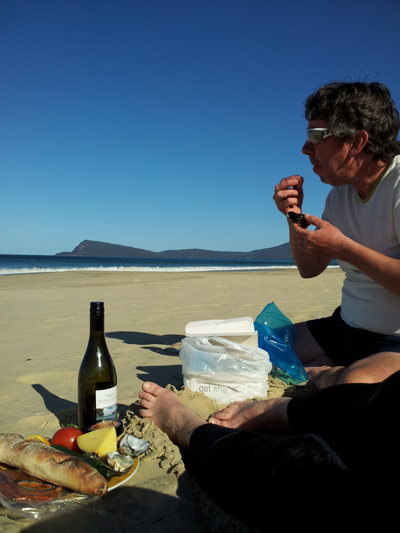
We took in the sights at the neck and pedalled on a short distance to the National Park camping ground. The weather was now glorious and we sat on Adventure Bay beach virtually alone. Looking across the bay and the shore break one can see the headland that protects the fishing village of Adventure Bay. Just six kilometres away Rob Pennicott began his multi award winning Wilderness Cruises. On these cruises seals, dolphins, shearwaters, albatross and other wildlife are common sights as you pass under vertical cliffs of dolerite columns. In season you might be lucky enough to see whales.
The next morning we awoke to rain for the return ride to the ferry. The long downhill glide to Adventure Bay was somewhat more difficult with rain and wind adding to what seemed a continuous rise. We missed the ferry by five minutes but cycling is all about slowing down and taking life as it comes.
From Kettering we rode over to Oyster Cove, infamous as the site where 47 Tasmanian Aboriginal survivors of fifteen year’s incarceration at Wybalenna on Flinders Island were forcibly returned in 1847. From Oyster Cove the loop ride on the Channel Highway continues north to Hobart through Margate, Kingston and Taroona. We were heading back to the Huon Valley, so from Oyster Cove we rode over the saddle to Nicholls Rivulet and Cygnet. By the time we arrived in Cygnet we were battling a strong headwind and we relaxed at the Bottom Pub (as distinct from the Top Pub). The pub owner had a storage garage and was happy to lock away the bikes for the night, so we had a celebratory night without the tent. In the chill of the next morning we left early and rode back along the Channel Highway to Lucaston. France was now within reach.
The real beauty of the Huon–D’Entrecasteaux ride is it creates an opportunity for those inexperienced in cycle tourism to pack bikes for flights, conform to luggage limits, estimate daily distances, check routes for difficulties, test clothing and camping needs and be aware of food, water and personal requirements. All this in an easily accessible part of Tasmania with so much to offer.
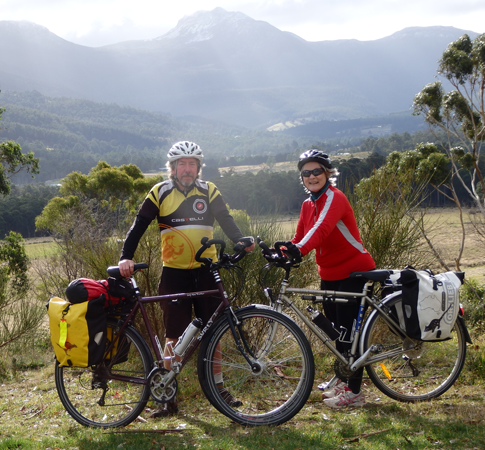
From the author
Australia can also develop long distance cycle routes by connecting rail trails through the use of back roads and old highways. An example would be making a continuous signed route across Victoria while connecting two Rail Trails by back roads from Melbourne to Tallarook, Mansfield to Wangaratta via Benalla and Beechworth to Wodonga. We need lower speed limits on these scenic routes to promote tourism and recreational road use. If people wish to drive at high speed then they have the motorways. As part of this concept the author and his wife have developed a cycle trail guide with notes for the Huon-D’Entrecasteaux route. We are continuing to lobby for consistent speed limits and improved signage.
Ride On content is editorially independent, but is supported financially by members of Bicycle Network. If you enjoy our articles and want to support the future publication of high-quality content, please consider helping out by becoming a member.

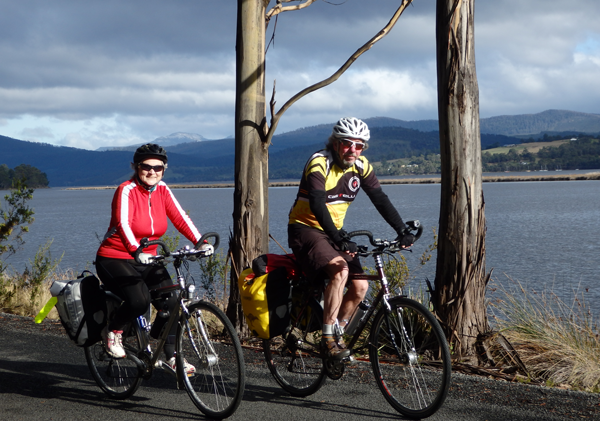


The Huon Valley Council is updating its Huon Trail website with cycle touring notes by October 2015.
I was wondering if there is any push to seal the dirt section on the southern end of the Pelverata Rd? This would be a wonderful alternative to riding down the Huon Hwy from Vince’s saddle – for those of us with road bikes not too keen on dirt roads or busy highways.
Hi Steven, I haven’t heard any such proposal and I can’t imagine the state government justifying the expenditure.